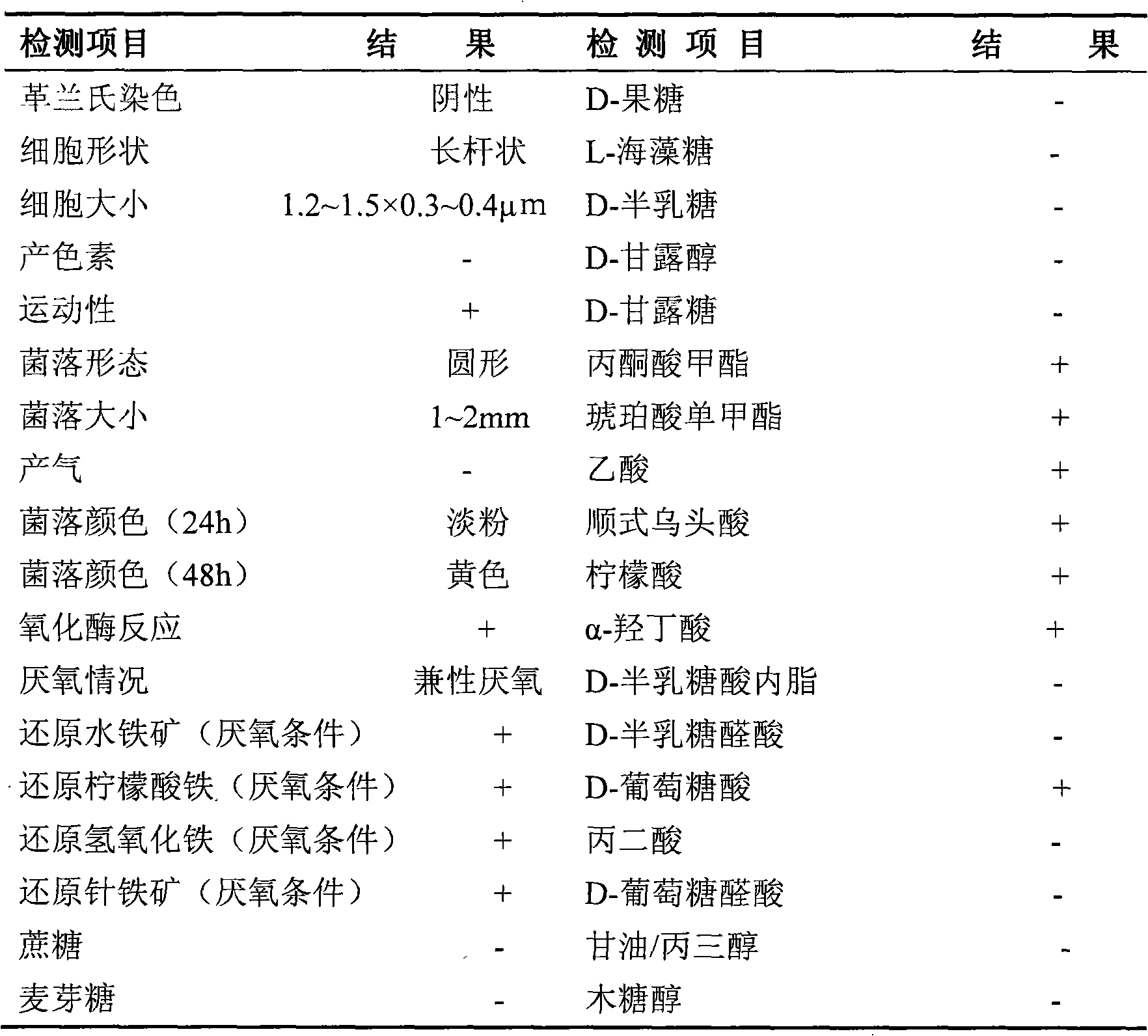Iron-reducing comamonas and application thereof
A technology of Comamonas and microbial strains, applied in the direction of bacteria, microorganisms, biochemical equipment and methods, etc., can solve the problems of inability to use organic matter, not yet found Comamonas, and high environmental requirements
- Summary
- Abstract
- Description
- Claims
- Application Information
AI Technical Summary
Problems solved by technology
Method used
Image
Examples
Embodiment 1
[0023] Embodiment 1: Separation, purification of bacterial classification
[0024] Take 5g ancient forest soil sample in 100mL liquid medium, the medium is composed of (g / L): AQDS (anthraquinone-2,6-disulfonic acid) 0.0412g, sodium acetate 1.36g, NaHCO 3 2.5g, NH 4 Cl 0.25g, NaH 2 PO 4 2H 2 O 0.678g, KCl 0.1g, vitamin solution 10.0mL (each liter of vitamin solution contains: biotin 2.0mg, folic acid 2.0mg, vitamin B 6 10.0mg, riboflavin 5.0mg, vitamin B 1 50mg, Niacin 5.0mg, Pantothenic Acid 5.0mg, Vitamin B 12 0.1mg, lipoic acid 5.0mg), trace element solution 10.0mL (each liter of trace element solution contains: nitrilotriacetic acid 1.5g, MgSO 4 ·7H 2 O 3.0g, MnSO 4 ·H 2 O 0.5g, NaCl 1.0g, FeSO 4 ·7H 2 O 0.1g, CoCl 2 ·6H 2 O 0.1g, CaCl 2 0.1g, ZnSO4 ·7H 2 O 0.1g, CuSO 4 ·5H 2 O 0.01g, AlKSO 4 12H 2 O 0.01g, H 3 BO 3 0.01g, Na 2 m 0 o 4 0.01g, NiCl 2 ·6H 2 O 0.024g), pH 5.0-5.5. Before inoculation, the culture medium is filled with high-purity m...
Embodiment 2
[0025] Embodiment 2: the identification of strain
[0026] (1) Determination of physiological and biochemical properties:
[0027] Table 1. Physiological and biochemical characteristics of CY01 strain
[0028]
[0029] Note: + indicates that it can be used; - indicates that it cannot be used
[0030] (2) Molecular biological identification
[0031] SDS-proteinase K, chloroform-isoamyl alcohol (volume ratio 24:1) extraction and 0.6 volume isopropanol precipitation were used to extract the total bacterial DNA. Bacterial 16S rDNA general primers F8 and R1542 were used to amplify bacterial 16S rDNA, and obvious bands appeared around 1500 bp. The PCR amplification product was recovered and sequenced. The obtained DNA sequence was input into GenBank, and the database was checked by Blastn program. All sequences were compared and analyzed. Combined with the results of the above physiological and biochemical characteristics and 16S rDNA sequence, the strain should belong to the...
Embodiment 3
[0032] Example 3: Identification of reducing activity
[0033] The electron donor is glucose and the electron acceptor is ferrihydrite
[0034] Medium formula: 10g of hydrous iron ore per liter of deionized water, NaHCO 3 2.5g, NH 4 Cl0.25g, NaH 2 PO 4 2H 2 O 0.678g, KCl 0.1g, glucose 0.9008g, each 10.0mL of vitamin solution and trace element solution (the formula of vitamin solution and trace element solution is the same as in Example 1), pH 5.0~5.5; When the glucose is separated from other components, the glucose and other components are mixed after sterilization, and then filled with high-purity mixed gas (N 2 / CO 2 =80 / 20)≥1 hour, inoculate the C. ferrireducens CY01 bacterial suspension to make the number of bacteria reach 10 8 / mL, static anaerobic culture at 30°C, and a control without bacteria was set at the same time. To observe the color change of the culture solution, take 4 mL of the culture solution in 16 mL of 0.5M HCl solution (M represents the number of...
PUM
 Login to View More
Login to View More Abstract
Description
Claims
Application Information
 Login to View More
Login to View More - R&D
- Intellectual Property
- Life Sciences
- Materials
- Tech Scout
- Unparalleled Data Quality
- Higher Quality Content
- 60% Fewer Hallucinations
Browse by: Latest US Patents, China's latest patents, Technical Efficacy Thesaurus, Application Domain, Technology Topic, Popular Technical Reports.
© 2025 PatSnap. All rights reserved.Legal|Privacy policy|Modern Slavery Act Transparency Statement|Sitemap|About US| Contact US: help@patsnap.com


